- Last week, cryptoassets continued to underperform traditional assets as the general market mood turned bearish following a renewed weakness in US regional bank stocks.
- Our Cryptoasset Sentiment Index is still signalling a bearish sentiment and therefore very attractive risk-reward for bitcoin. There is also a bullish divergence on the intraday sentiment score which suggests that the market is poised for a short-term reversal.
- Chart of the Week: The relative performance of bitcoin vs gold tends to gyrate with changes in cross asset risk appetite. In other words, a renewed risk on period will most likely reassert bitcoin’s performance leadership over gold. In that context, only a small capital rotation from gold to bitcoin could have very significant performance effects on the digital gold alternative. You only need between 3%-4% in capital rotation for BTC to double from here.
Chart of the Week
Only a small percentage of capital rotation from gold is needed for BTC to double from here
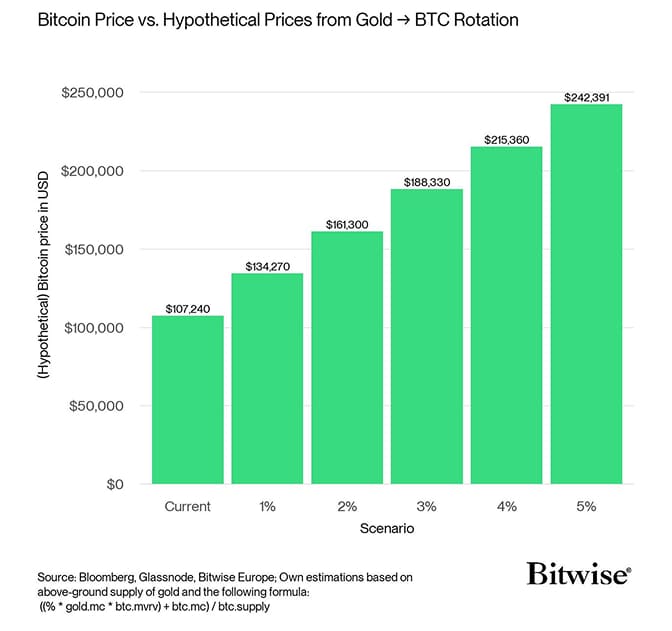
Performance
Last week, cryptoassets continued to underperform traditional assets as the general market mood turned bearish following a renewed weakness in US regional bank stocks.
Some regional banking stocks declined by more than -10% on Thursday last week due to increasing signs of interbank funding stress. For instance, the GC repo-Fed Funds Rate spread increased to 21 basis points – its highest level in 2025 so far.
This risk off market environment in traditional financial markets led to a decline in cryptoassets as well in a “sell-what-you-can” fashion. As result, bitcoin and ether revisited their intraday lows last week.
We still think that various sentiment indicators signal a significant degree of seller exhaustion which suggests that downside risks are very limited. To the contrary, the bullish divergence in our intraday Cryptoasset Sentiment Index suggests that bitcoin is poised for a rebound in the short term.
The negative performance reaction by cryptoassets also appears to be overblown for the following reasons:
- Bitcoin and other cryptoassets are independent of the traditional banking system – if anything, increasing systemic banking risks are net positive for bitcoin as a counterparty risk-free asset.
- Increasing funding stress implies a higher probability that the Fed might end Quantitative Tightening (“QT”) of its bond portfolio rather sooner than later, implying a stronger acceleration in US and global liquidity growth. Powell just recently made comments in that direction.
- The risk off environment has led to a decline in US long-term yields (10yr yield < 4%) which is supporting a renewed recovery in US housing – recent housing data have already surprised to the upside suggesting a new business cycle upturn in the US.
In fact, looking back at the Silicon Valley Bank bankruptcy in March 2023, bitcoin recovered swiftly following the event with a performance of +47% after only 1 month following the event.
Note that the Fed is about to meet on the 29th of October again where Fed Funds Futures price in a 98% probability for another 25 bps rate cut.
Another key catalyst for a swift recovery in bitcoin over the coming months could be a capital rotation from gold into bitcoin. The yellow metal has experienced a meteoric rise this year due to prospects of easier monetary policy and increasing worries about US fiscal debt.
As pointed out in our latest Bitcoin Macro Investor report, gold's performance has been more sensitive to changes in monetary policy and the US Dollar while bitcoin has been more geared towards changes in global growth expectations from a pure quantitative perspective. Therefore, we expect that a renewed business cycle upturn in the US - induced by easier monetary policy - will also affect bitcoin positively with a lag.
In fact, the relative performance of bitcoin vs gold tends to gyrate with changes in cross asset risk appetite. In other words, a renewed risk on period will most likely reassert bitcoin's performance leadership over gold.
In that context, only a small capital rotation from gold to bitcoin could have very significant performance effects on the digital gold alternative. You only need between 3%-4% in capital rotation for BTC to double from here (Chart-of-the-Week).
This is not a far-fetched scenario. For instance, in 2020 bitcoin has seen its rally commence to new all-time highs in October 2020 the moment gold's rally had stalled in July 2020.
We think such a performance pattern is likely going to repeat itself especially if gold's rally would pause over the coming months. In this context, it is generally worth noting that gold's rally needs a significantly higher amount of capital to be sustained relative to bitcoin. This is becoming a headwind for gold.
Cross Asset Performance (Week-to-Date)
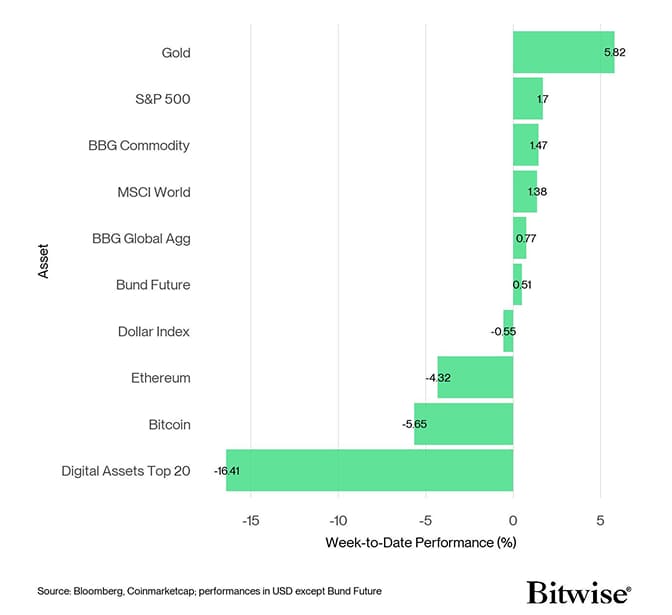 Source: Bloomberg, Coinmarketcap; performances in USD exept Bund Future
Top 10 Cryptoasset Performance (Week-to-Date)
Source: Bloomberg, Coinmarketcap; performances in USD exept Bund Future
Top 10 Cryptoasset Performance (Week-to-Date)
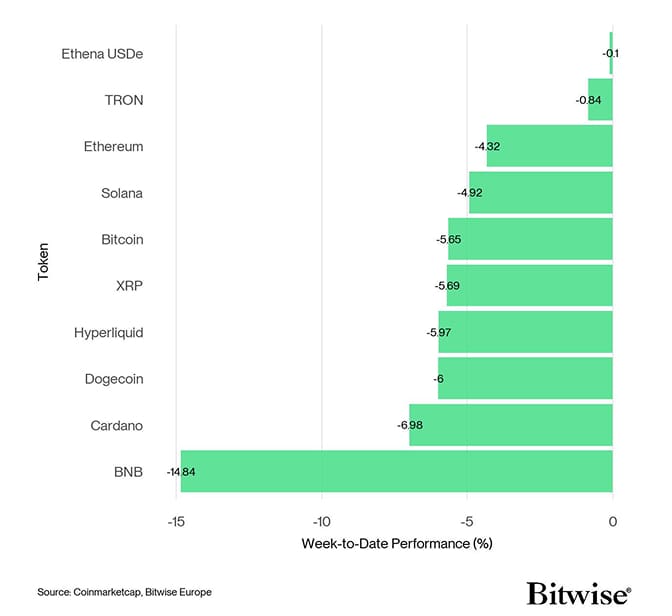 Source: Coinmarketcap
Source: Coinmarketcap
In general, among the top 10 crypto assets (ex stablecoins) TRON, Ethereum, and Solana were the relative outperformers.
Overall, altcoin outperformance vis-à-vis bitcoin has continued to be low last week, with only 35% of our tracked altcoins managing to outperform bitcoin on a weekly basis. However, Ethereum slightly outperformed bitcoin last week.
Sentiment
Our in-house “Cryptoasset Sentiment Index” has improved since hitting its lowest level since the “Yen Carry Trade Unwind” in early August 2024. Yet, sentiment still remains deeply negative at -0.62 but has been improving over the weekend.
At the moment, 3 out of 15 indicators are above their short-term trend.
Last week, the Crypto Hedge Fund Beta, BTC Exchange Inflows and Bitcoin Long Futures Liquidation Dominance metrics showed positive momentum.
The Crypto Fear & Greed Index currently signals a “Fear” level of sentiment as of this morning, dropping 10 points to 30, since the beginning of last week.
Performance dispersion among cryptoassets has trended down slightly last week, signalling that altcoins have continued to be highly correlated with the performance of bitcoin.
Altcoin outperformance vis-à-vis Bitcoin has increased from last week, with around 35% of our tracked altcoins managing to outperform Bitcoin on a weekly basis. Ethereum also slightly outperformed Bitcoin last week.
In general, increasing (decreasing) altcoin outperformance tends to be a sign of increasing (decreasing) risk appetite within cryptoasset markets and the latest altcoin outperformance signals an increasing risk appetite at the moment.
Sentiment in traditional financial markets as measured by our in-house measure of Cross Asset Risk Appetite (CARA) has dropped dramatically on the back of continued risk-off crypto sentiment, the China-tariff hangover, and US regional bank weakness, as our readings show a drop from 0.32 to 0.04.
Fund Flows
While weekly fund flows into global crypto ETPs flipped negative last week, large outflows across Bitcoin, but inflows into Ethereum, and ex-Ethereum altcoin products still suggest steady allocation. Baskets & Thematics however saw net outflows last week.
Global crypto ETPs saw around -786.0 mn USD in weekly net outflows across all types of cryptoassets, after +2948.0 mn USD in net inflows the previous week.
Global Bitcoin ETPs saw net outflows totalling -1028.6 USD last week, of which -1225.4 mn USD in net outflows were related to US spot Bitcoin ETFs.
The Bitwise Bitcoin ETF (BITB) in the US experienced net outflows, totalling -128.2 mn USD last week.
In Europe, the Bitwise Physical Bitcoin ETP (BTCE) experienced net inflows equivalent to 1.4 mn USD, while the Bitwise Core Bitcoin ETP (BTC1) experienced minor net outflows of -2.2 mn USD.
The Grayscale Bitcoin Trust (GBTC) has posted net outflows of -298.3 mn USD. The iShares Bitcoin Trust (IBIT), however, experienced net outflows of around -278.6 mn USD last week.
Meanwhile, flows into global Ethereum ETPs maintained its positive trend last week, with around 159.8 mn USD in net inflows.
US spot Ethereum ETFs, also recorded net outflows of around -311.8 mn USD on aggregate. The Grayscale Ethereum Trust (ETHE), has posted net outflows of -101 mn USD.
The Bitwise Ethereum ETF (ETHW) in the US has also posted net outflows of -23.6 mn USD.
In Europe, the Bitwise Physical Ethereum ETP (ZETH) saw net outflows of -9.1 mn USD while the Bitwise Ethereum Staking ETP (ET32) saw minor net inflows of +0.3 mn USD.
Altcoin ETPs ex Ethereum also experienced net inflows of +89.9 mn USD last week. Thematic & basket crypto ETPs, however, posted net outflows of -7.1 mn USD on aggregate last week. The Bitwise MSCI Digital Assets Select 20 ETP (DA20) saw minor net inflows of +1 mn USD.
Global crypto hedge funds exposure to Bitcoin declined every day last week. The 20-day rolling beta of hedge fund performance trended from 0.69 to 0.64.
On-Chain Data
Sell-side pressure remains high with Intraday Spot Buying minus Selling volume remaining deeply negative, with net selling volumes at approximately -$2.46 bn on bitcoin spot exchanges by week-end.
Bitcoin whales (entities that hold at least 1k BTC) have exhibited a notable change in behaviour following the recent market correction, shifting from accumulation back into net distribution. Over the past week, this cohort has deposited approximately +3.3k BTC to exchanges, suggesting a degree of de-risking among larger holders.
Furthermore, based on recent data from Glassnode, the overall downward trend in exchange-held Bitcoin reserves has continued its downward trend. The current level stands at 2.85 million BTC, representing approximately 14.3% of the total circulating supply - a 50 bps decrease from last week.
Despite the significant deleveraging across derivative markets, the relative unrealized losses held by Bitcoin investors remained remarkably contained, peaking at $18.6bn, equivalent to just 0.5% of the market cap.
The Short-Term Holder Cost-Basis, residing at $113.2k, remains a critical target for the spot price to overcome for continued bullish momentum. A decisive reclamation of this level would return many new investors to a position of profit and markedly improve market sentiment.
Assessing the on-chain volume profile, a dense cluster of coins exists between $93K and $118K, effectively forming the core boundary between continued bull and bear market conditions. Therefore, a decisive move above the upper end of this range at $118K would indicate a meaningful display of market strength.
All in all, on-chain metrics point to a constructive backdrop. Unrealized losses remained shallow across the drawdown, and the market is beginning to rebound towards the Short-Term Holder Cost Basis, which remains a critical level to reclaim. However, until price can break convincingly above the $118K boundary, conditions remain compressed within the current range rather than decisively trending.
Futures, Options & Perpetuals
Over the past week, BTC perpetual futures open interest declined by –18.9k BTC across all exchanges, alongside a further –760 BTC reduction in CME futures. This continued contraction in futures exposure indicates that traders remain cautious in the aftermath of the recent deleveraging event, opting to scale back risk until clearer directional momentum re-emerges.
BTC perpetual funding rates have contracted back to net neutral, reflecting a balanced positioning between longs and shorts. This further reinforces the observation that investors remain uncertain on directional bias, with neither side displaying strong conviction at present.
In general, when the funding rate is positive (negative), long (short) positions periodically pay short (long) positions, which is indicative of bullish (bearish) sentiment.
The BTC 3-months annualised basis decreased last week to around 6.8% p.a., averaged across various futures exchanges.
BTC options open interest has increased by approximately +39.1k BTC, while the put–call open interest ratio has risen to 0.66, a level exceeded on only 13 trading days recording a higher value this cycle. This signals a notable uptick in demand for downside protection, consistent with a market positioning defensively amid elevated uncertainty.
Meanwhile, the 25-delta skew across all major BTC option tenors has risen over the week and remains elevated, further supporting the view that traders are increasingly positioning for downside protection.
BTC option implied volatilities also increased compared to last week, consistent with the uptick in 1-month realized volatility.
At the time of writing, implied volatilities of 1-month ATM Bitcoin options are currently at around 46.5% p.a. on Deribit, its largest value since December 2024.
Bottom Line
- Last week, cryptoassets continued to underperform traditional assets as the general market mood turned bearish following a renewed weakness in US regional bank stocks.
- Our Cryptoasset Sentiment Index is still signalling a bearish sentiment and therefore very attractive risk-reward for bitcoin. There is also a bullish divergence on the intraday sentiment score which suggests that the market is poised for a short-term reversal.
- Chart of the Week: The relative performance of bitcoin vs gold tends to gyrate with changes in cross asset risk appetite. In other words, a renewed risk on period will most likely reassert bitcoin’s performance leadership over gold. In that context, only a small capital rotation from gold to bitcoin could have very significant performance effects on the digital gold alternative. You only need between 3%-4% in capital rotation for BTC to double from here.
Appendix
Bitcoin Price vs Cryptoasset Sentiment Index
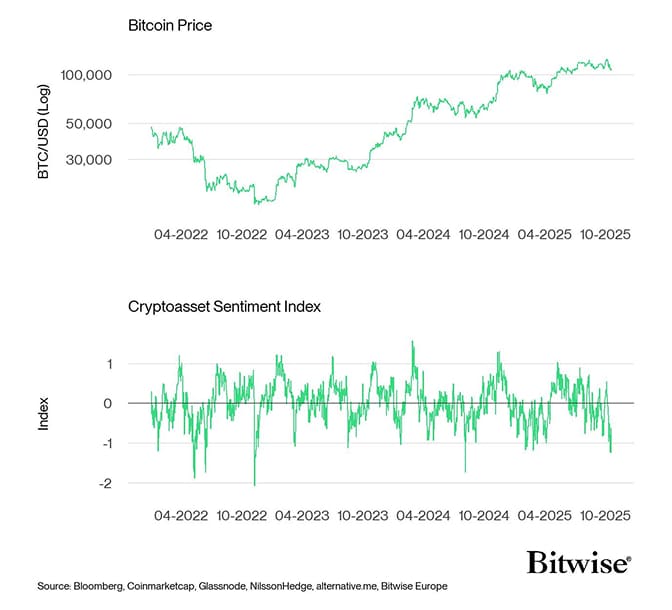 Source: Bloomberg, Coinmarketcap, Glassnode, NilssonHedge, alternative.me, Bitwise Europe
Cryptoasset Sentiment Index
Source: Bloomberg, Coinmarketcap, Glassnode, NilssonHedge, alternative.me, Bitwise Europe
Cryptoasset Sentiment Index
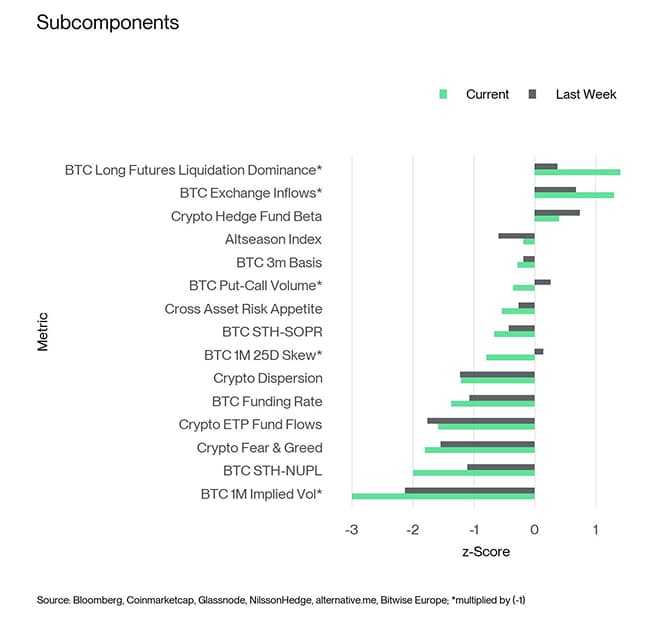 Source: Bloomberg, Coinmarketcap, Glassnode, NilssonHedge, alternative.me, Bitwise Europe; *multiplied by (-1)
Cryptoasset Sentiment Index
Source: Bloomberg, Coinmarketcap, Glassnode, NilssonHedge, alternative.me, Bitwise Europe; *multiplied by (-1)
Cryptoasset Sentiment Index
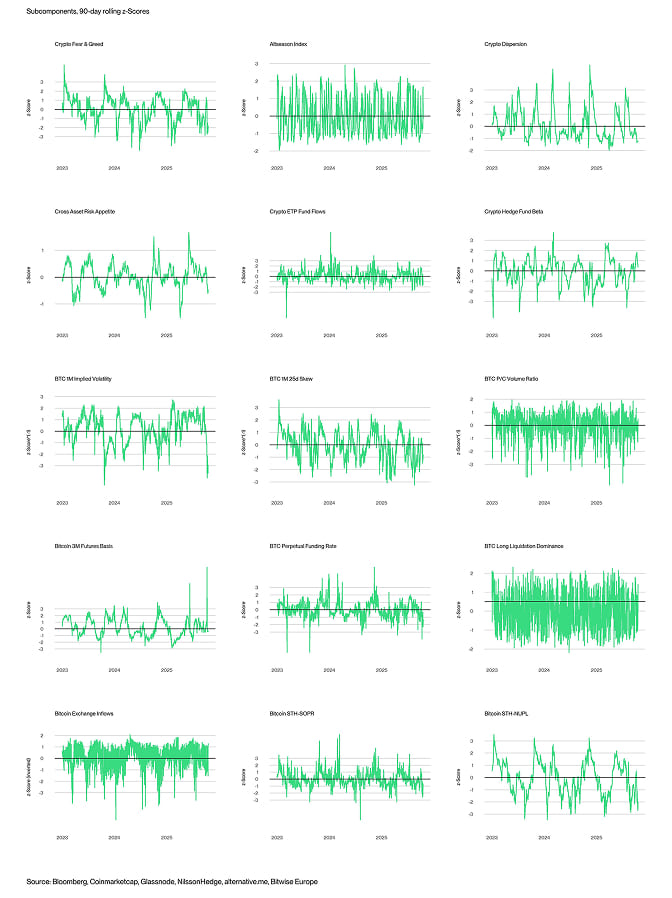 Source: Bloomberg, Coinmarketcap, Glassnode, NilssonHedge, alternative.me, Bitwise Europe
TradFi Sentiment Indicators
Source: Bloomberg, Coinmarketcap, Glassnode, NilssonHedge, alternative.me, Bitwise Europe
TradFi Sentiment Indicators
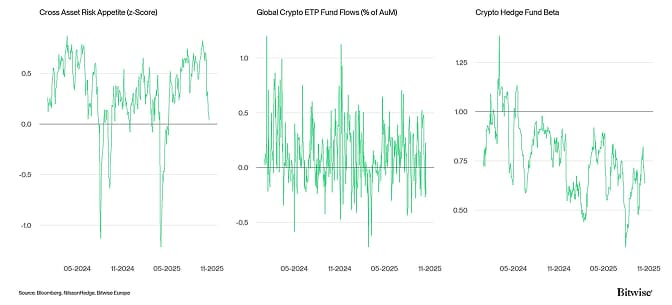 Source: Bloomberg, NilssonHedge, Bitwise Europe
Crypto Sentiment Indicators
Source: Bloomberg, NilssonHedge, Bitwise Europe
Crypto Sentiment Indicators
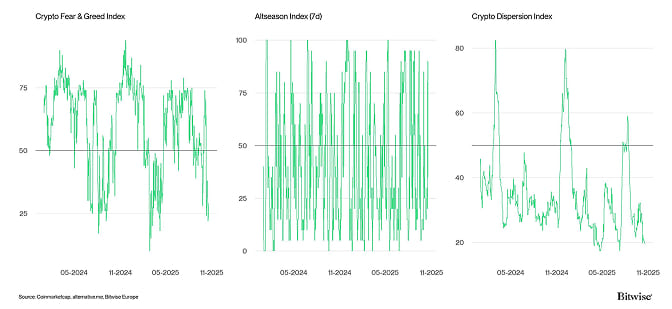 Source: Coinmarketcap, alternative.me, Bitwise Europe
Crypto Options' Sentiment Indicators
Source: Coinmarketcap, alternative.me, Bitwise Europe
Crypto Options' Sentiment Indicators
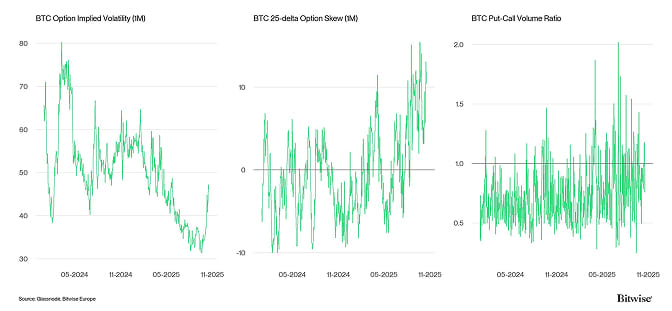 Source: Glassnode, Bitwise Europe
Crypto Futures & Perpetuals' Sentiment Indicators
Source: Glassnode, Bitwise Europe
Crypto Futures & Perpetuals' Sentiment Indicators
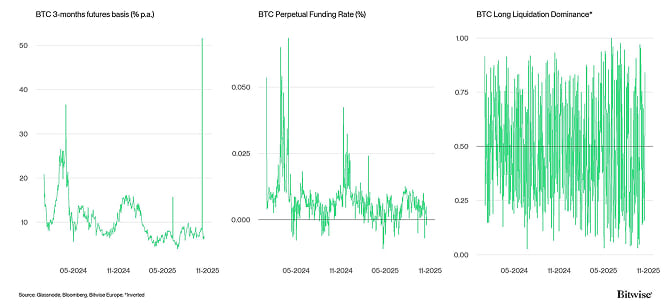 Source: Glassnode, Bitwise Europe; *Inverted
Crypto On-Chain Indicators
Source: Glassnode, Bitwise Europe; *Inverted
Crypto On-Chain Indicators
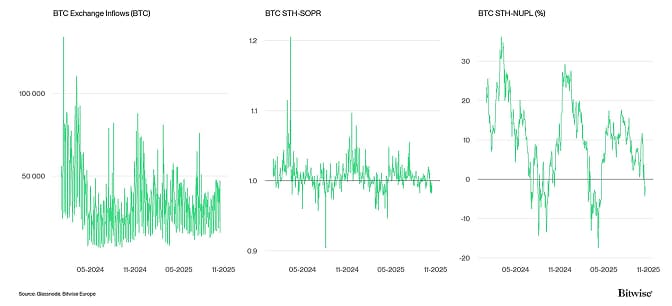 Source: Glassnode, Bitwise Europe
Bitcoin vs Crypto Fear & Greed Index
Source: Glassnode, Bitwise Europe
Bitcoin vs Crypto Fear & Greed Index
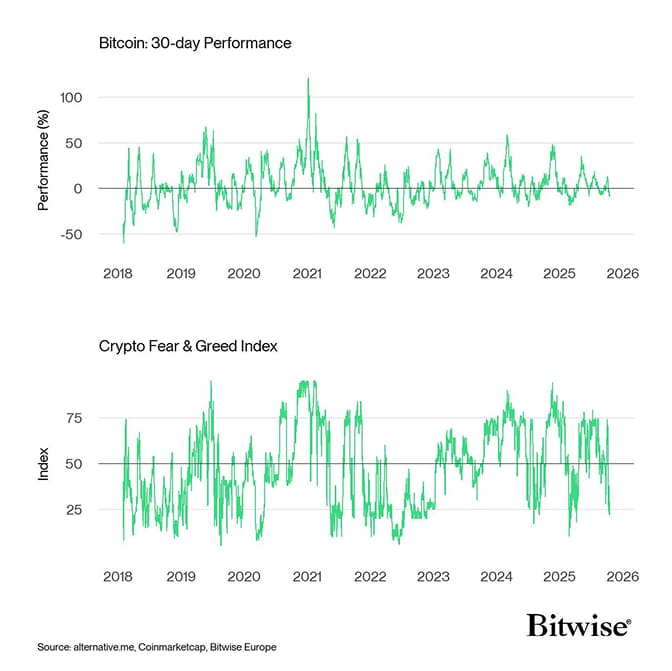 Source: alternative.me, Coinmarketcap, Bitwise Europe
Cryptoasset Sentiment Index: Daily vs Hourly
Source: alternative.me, Coinmarketcap, Bitwise Europe
Cryptoasset Sentiment Index: Daily vs Hourly
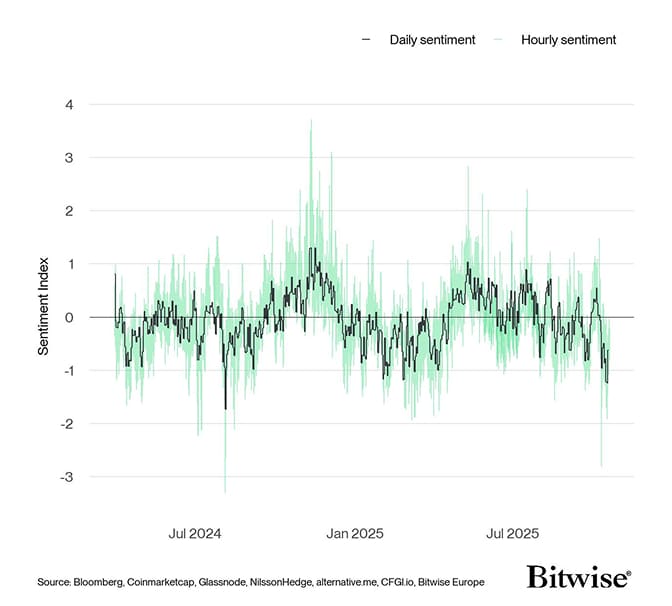 Source: Bloomberg, Coinmarketcap, Glassnode, NilssonHedge, alternative.me, CFGI.io, Bitwise Europe
Bitcoin vs Global Crypto ETP Fund Flows
Source: Bloomberg, Coinmarketcap, Glassnode, NilssonHedge, alternative.me, CFGI.io, Bitwise Europe
Bitcoin vs Global Crypto ETP Fund Flows
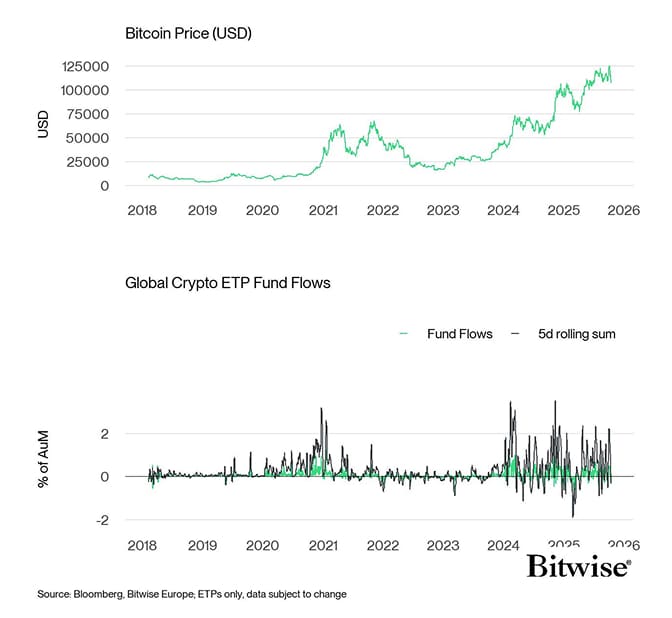 Source: Bloomberg, Bitwise Europe; ETPs only, data subject to change
Global Crypto ETP Fund Flows
Source: Bloomberg, Bitwise Europe; ETPs only, data subject to change
Global Crypto ETP Fund Flows
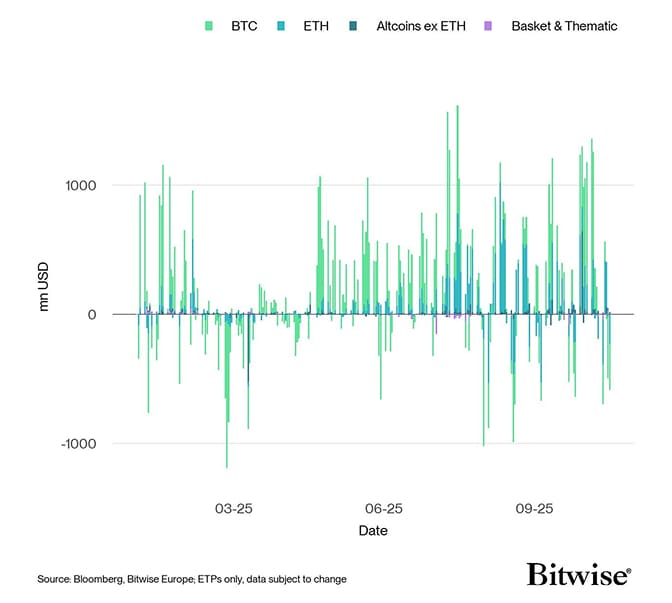 Source: Bloomberg, Bitwise Europe; ETPs only; data subject to change
US Spot Bitcoin ETF Fund Flows
Source: Bloomberg, Bitwise Europe; ETPs only; data subject to change
US Spot Bitcoin ETF Fund Flows
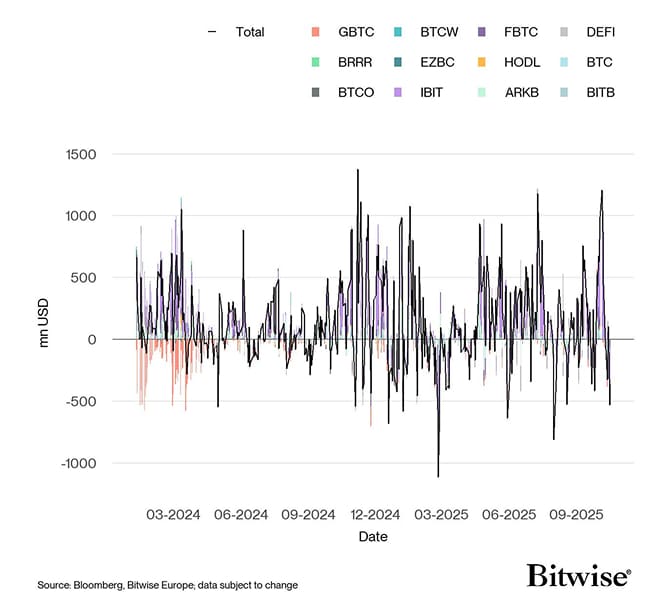 Source: Bloomberg, Bitwise Europe; data subject to change
US Spot Bitcoin ETFs: Flows since launch
Source: Bloomberg, Bitwise Europe; data subject to change
US Spot Bitcoin ETFs: Flows since launch
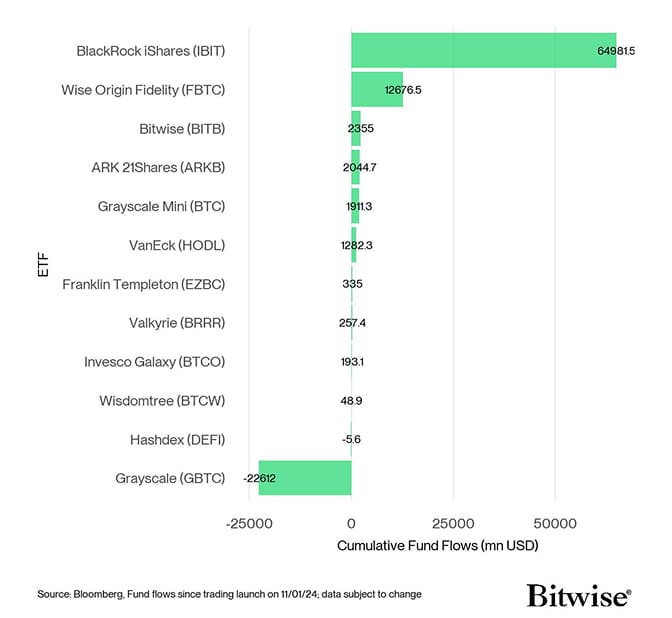 Source: Bloomberg, Fund flows since traiding launch on 11/01/24; data subject to change
US Spot Bitcoin ETFs: 5-days flow
Source: Bloomberg, Fund flows since traiding launch on 11/01/24; data subject to change
US Spot Bitcoin ETFs: 5-days flow
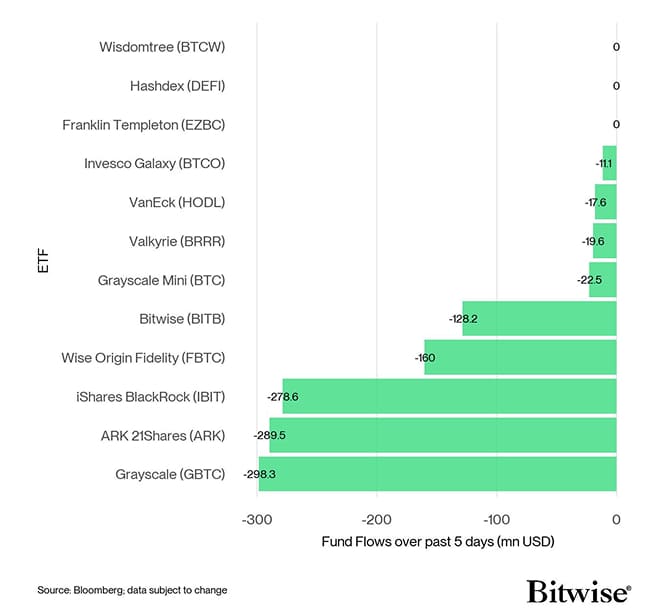 Source: Bloomber; data subject to change
US Bitcoin ETFs: Net Fund Flows since 11th Jan mn USD
Source: Bloomber; data subject to change
US Bitcoin ETFs: Net Fund Flows since 11th Jan mn USD
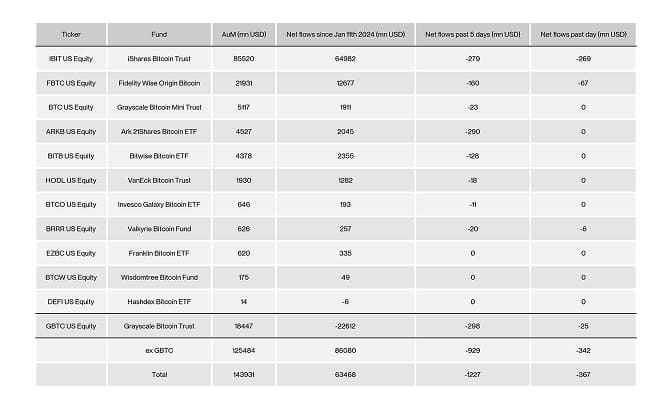 Source: Bloomberg, Bitwise Europe; data as of 17-10-2025
US Spot Ethereum ETF Fund Flows
Source: Bloomberg, Bitwise Europe; data as of 17-10-2025
US Spot Ethereum ETF Fund Flows
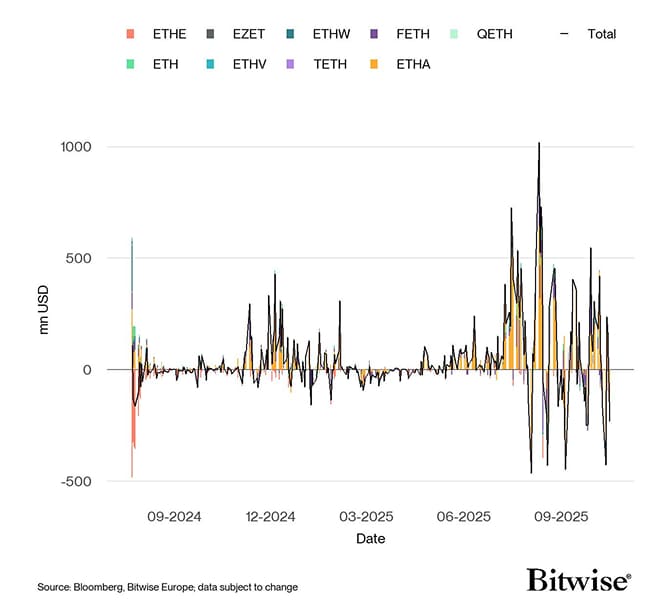 Source: Bloomberg, Bitwise Europe; data subject to change
US Spot Ethereum ETFs: Flows since launch
Source: Bloomberg, Bitwise Europe; data subject to change
US Spot Ethereum ETFs: Flows since launch
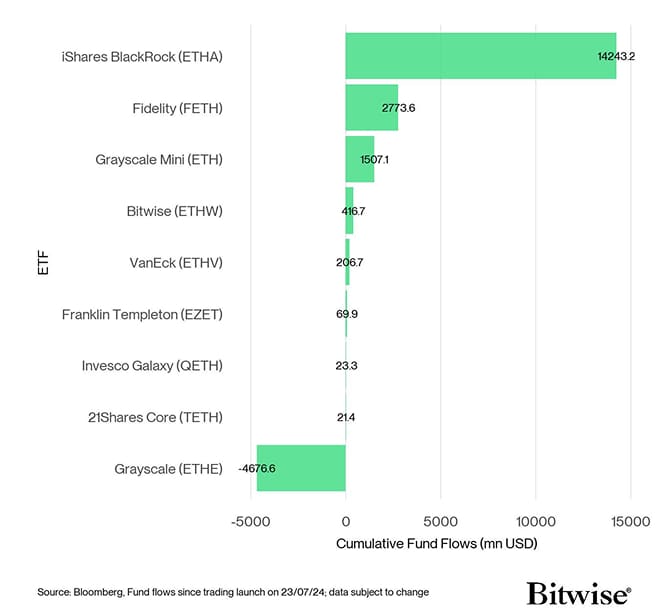 Source: Bloomberg, Fund flows since trading launch on 23/07/24; data subject on change
US Spot Ethereum ETFs: 5-days flow
Source: Bloomberg, Fund flows since trading launch on 23/07/24; data subject on change
US Spot Ethereum ETFs: 5-days flow
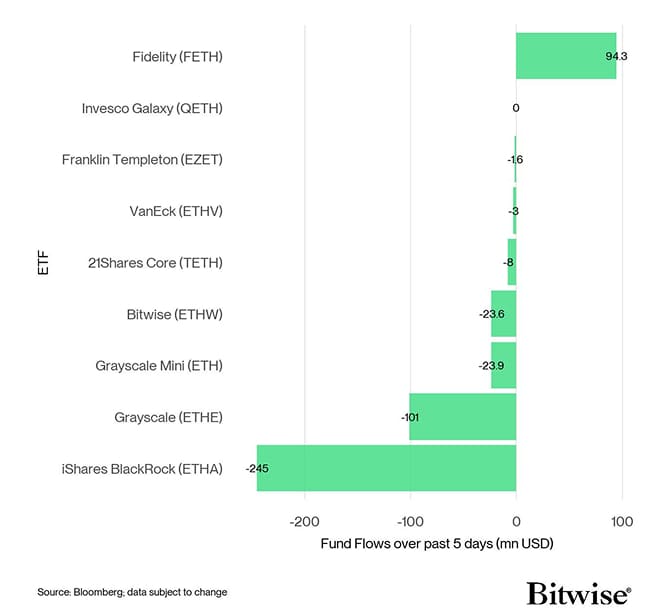 Source: Bloomberg; data subject on change
US Ethereum ETFs: Net Fund Flows since 23rd July
Source: Bloomberg; data subject on change
US Ethereum ETFs: Net Fund Flows since 23rd July
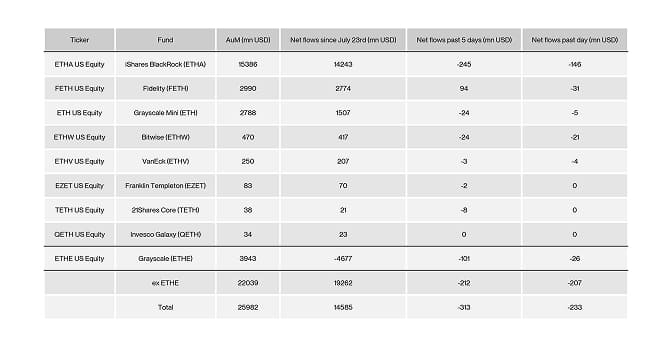 Source: Bloomberg, Bitwise Europe; data as of 17-10-2025
Bitcoin vs Crypto Hedge Fund Beta
Source: Bloomberg, Bitwise Europe; data as of 17-10-2025
Bitcoin vs Crypto Hedge Fund Beta
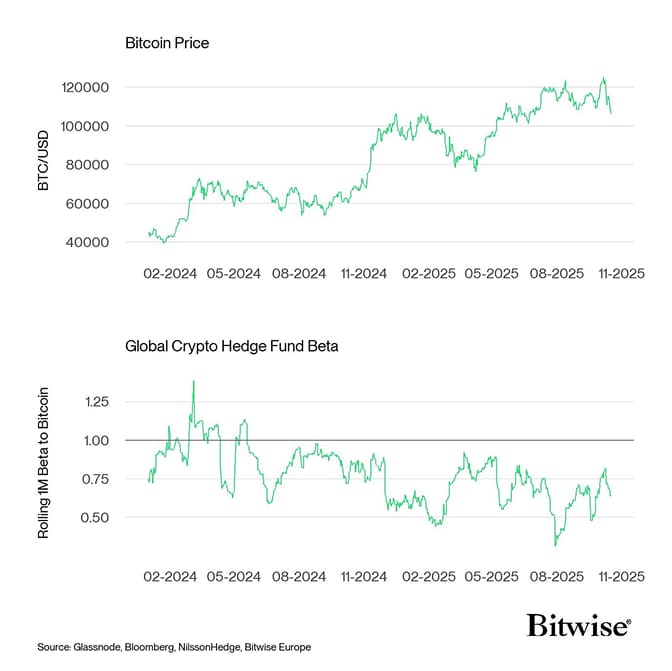 Source: Glassnode, Bloomberg, NilssonHedge, Bitwise Europe
Altseason Index
Source: Glassnode, Bloomberg, NilssonHedge, Bitwise Europe
Altseason Index
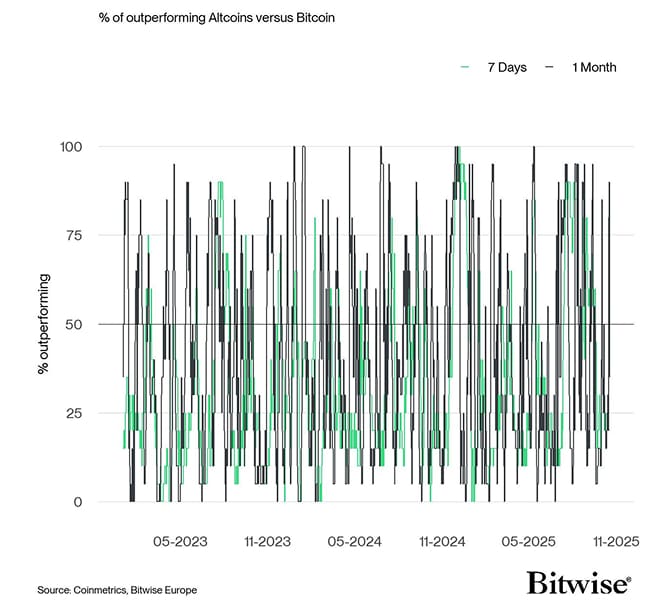 Source: Coinmetrics, Bitwise Europe
Bitcoin vs Crypto Dispersion Index
Source: Coinmetrics, Bitwise Europe
Bitcoin vs Crypto Dispersion Index
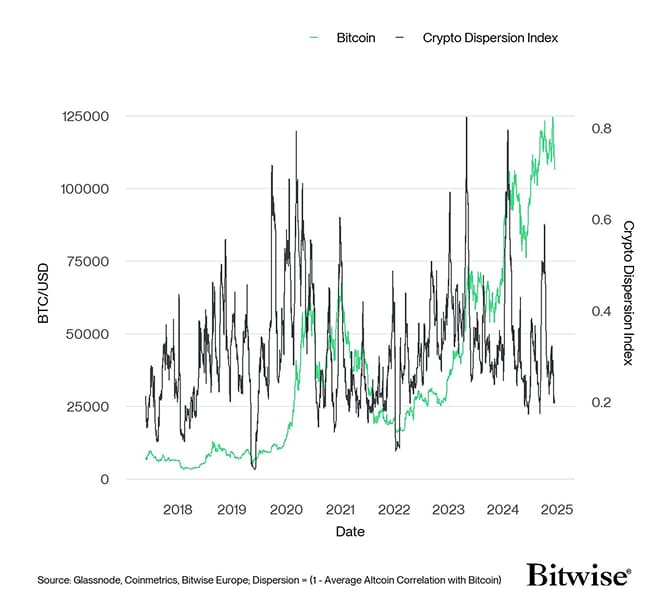 Source: Coinmarketcap, Bitwise Europe; Dispersion = (1 - Average Altcoin Correlation with Bitcoin)
Bitcoin Price vs Futures Basis Rate
Source: Coinmarketcap, Bitwise Europe; Dispersion = (1 - Average Altcoin Correlation with Bitcoin)
Bitcoin Price vs Futures Basis Rate
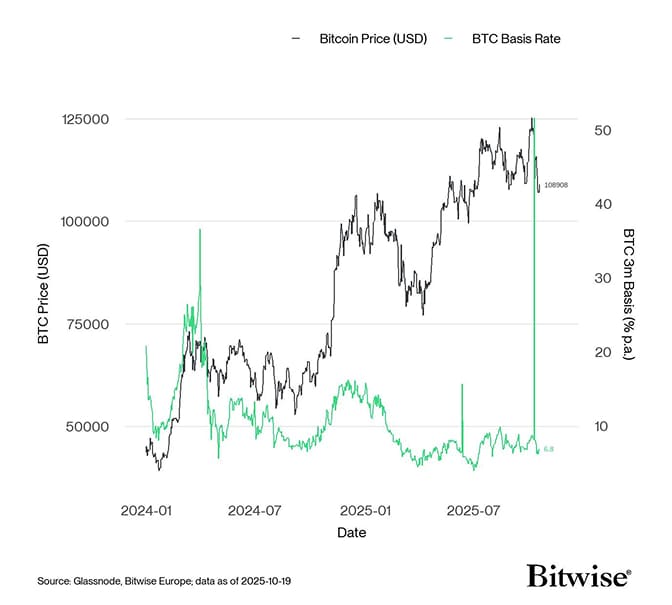 Source: Glassnode, Bitwise Europe; data as of 2025-10-19
Ethereum Price vs Futures Basis Rate
Source: Glassnode, Bitwise Europe; data as of 2025-10-19
Ethereum Price vs Futures Basis Rate
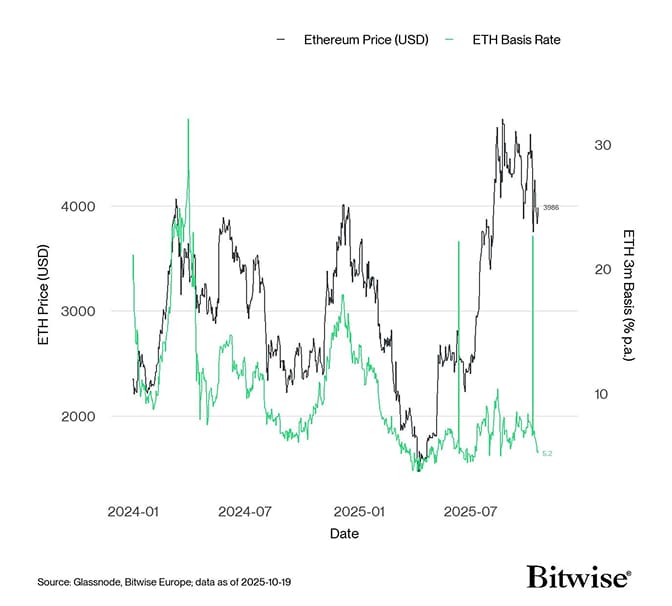 Source: Glassnode, Bitwise Europe; data as of 2025-10-19
BTC Net Exchange Volume by Size
Source: Glassnode, Bitwise Europe; data as of 2025-10-19
BTC Net Exchange Volume by Size
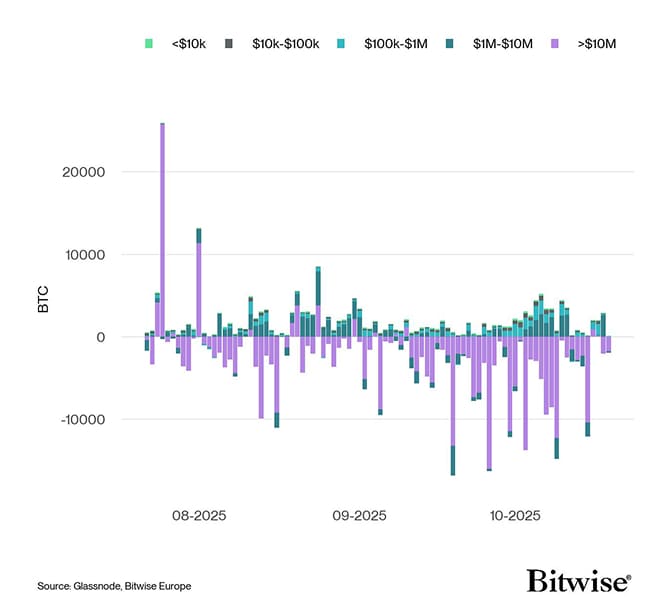 Source: Glassnode, Bitwise Europe
Source: Glassnode, Bitwise Europe
Important information:
This article does not constitute investment advice, nor does it constitute an offer or solicitation to buy financial products. This article is for general informational purposes only, and there is no explicit or implicit assurance or guarantee regarding the fairness, accuracy, completeness, or correctness of this article or the opinions contained therein. It is advised not to rely on the fairness, accuracy, completeness, or correctness of this article or the opinions contained therein. Please note that this article is neither investment advice nor an offer or solicitation to acquire financial products or cryptocurrencies.
Before investing in crypto ETPs, potentional investors should consider the following:
Potential investors should seek independent advice and consider relevant information contained in the base prospectus and the final terms for the ETPs, especially the risk factors mentioned therein. The invested capital is at risk, and losses up to the amount invested are possible. The product is subject to inherent counterparty risk with respect to the issuer of the ETPs and may incur losses up to a total loss if the issuer fails to fulfill its contractual obligations. The legal structure of ETPs is equivalent to that of a debt security. ETPs are treated like other securities.
